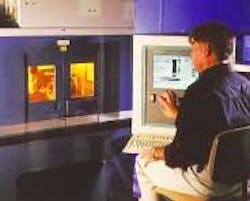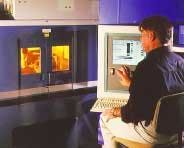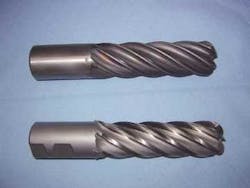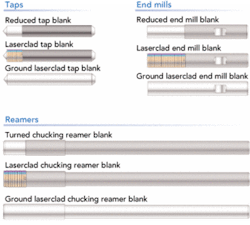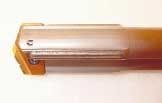Laser cladding makes the grade
Utilizing the laser for precise selective deposition of tool grade material could revolutionize the tool industry
In many instances, the production of high-quality cutting tools begins with the use of powder metals. Currently, powder metal processing requires the powder to be formed by gas atomization, which allows the powder particle to cool rapidly, forming a very small grain size, a common characteristic of powder metal materials. The use of high-speed steel (HSS) powders allows for the formation of more carbide forming elements. Thus, the small grain size and higher carbide formation results contribute to the improved hardness and wear characteristics of powder metal high-speed steel.
However, the cost of these materials typically is higher than traditional ingot metallurgy tool grade alloys. The additional processing required to form powder metal into bar stock for standard HSS cutting tool production generates significant costs, which necessitates a selling price of $20 to $30 per pound of bar stock. This cost factor has severely limited its acceptance for standard cutting tool production despite its significant attributes.
In the manufacturing sector laser deposition processes are gaining widespread acceptance for repair, refurbishment, and rapid prototyping. This process typically involves the use of powder that is efficiently melted by a laser beam and precisely deposited onto the substrate material. Characteristics of laser deposition processes include low thermal distortion, minimal metallurgical degradation to the substrate, relatively high deposition rates, and rapid solidification rates associated with the deposit. This combination of attributes makes the laser process an ideal candidate for selectively producing engineered microstructures for a wide variety of applications. [1-3] However, the ability to obtain the demanding properties required for tool components has provided a formidable challenge.
Realizing the potential of laser deposition, Alvord-Polk embarked on a research and development program to identify possible applications, evaluate and characterize laser deposition for existing products, and quantify potential savings resulting from this technology. Initial trials were conducted in conjunction with the Applied Research Laboratory, Pennsylvania State University (ARL Penn State) with subsequent development being performed at Alvord-Polk’s Millersburg, Pennsylvania facility. The results of this investigation indicated that by selectively laser-depositing a low-cost HSS blank with Rex 121™ it was possible to have powder metal quality with acceptable costs.
Figure 1 shows the five-axis system at Alvord-Polk that utilizes a 2kW CO2 laser and coaxial powder feed to precisely deposit high carbide containing material on tool blanks. A photograph of an as-deposited and as-ground 32mm diameter end mill produced with this system is shown in Figure 2, and Figure 3 shows schematically other tool applications currently being developed. Alvord-Polk has found that for many applications the laser deposit provides the required hardness and durability necessary for a tool component while reducing the costs associated with materials and ancillary operations.
The opportunities to apply laser deposition technology in the tool industry are constrained only by the materials that can be deposited, and significant research is being directed at formulating improved powder compositions specifically for laser processing for high-wear-resistant applications.[4, 5] The properties developed within the solidified deposit are established by alloy-induced transformations, composite strengthening through second-phase particles, or a combination of both. Composite microstructures, containing extremely hard particles in a hard but weldable matrix, offer significant opportunities for laser deposition of tool grade materials.
The use of laser deposition for tool grade material having a composite microstructure is already being commercialized. A cutting tool application now in production resulted from a cooperative effort between Alvord-Polk, Inc. and the Allied Machine and Engineering Company Corporation (Dover, OH). Special deep-hole insert drills require a chromium-plated or carbide-insert wear pad on the full diameter immediately behind the tungsten carbide insert. Alvord-Polk, working with ARL Penn State, developed a laser-clad material employing Rex 121 and a high-volume content of tungsten carbide particles. This combination of materials resulted in an excellent wear pad that could be selectively deposited in place of the chrome or brazed carbide wear pads. Figure 4 shows a deep-hole insert drill having a laser-deposited wear pad.
Test results on tools produced using this technique have surpassed expectations. The drills can operate at surface speeds up to two times faster than chromium electroplated tools, and wear resistance has been observed to be in excess of two to four times greater than chromium electroplating. It is also an economical alternative to the brazed or bolted-carbide wear pads because spent tools are simply returned for regrinding and a new laser deposit is provided for replacement.
Laser deposition to produce tool grade material offers the potential to revolutionize the tool industry. Processing relies on the ability of the laser to precisely deposit a highly engineered material only where needed on the cutting tool, minimizing the use of costly material and secondary operations. It has been shown that tools produced by this method exhibit performance in excess of conventional materials while decreasing manufacturing costs. Further implementation of this technology will be spurred by the development of new materials designed specifically for these applications.
Ronald E. Boyer ([email protected]) is president of Alvord-Polk, Inc. (Millersburg, PA). Richard P. Martukanitz ([email protected]) is head of the Laser Processing Division of the Applied Research Laboratory at Pennsylvania State University (State College, PA).
REFERENCES
1. Agarwal, A. and N. B. Dahotre, Laser Surface Engineering of Steel for Hard Refractory Ceramic Composite Coating, International J. Refractory Materials and Hard Metals, Vol. 17 (4), 283 (1999).
2. Mazumder, J., A. Schifferer, and J. Choi, “Direct Materials Deposition: Designed Macro and Microstructure,” Materials Research Innovations, Vol. 3, 118 (1999).
3. McCay M. H., N. B. Dahotre, J. A. Hopkins, T. D. McCay, and M. A. Riley, The Influence of Metals and Carbides During Laser Modification of Low Alloy Steel, Journal of Materials Science, Vol. 34, 5789 (1999).
4. Babu, S. S., R. P. Martukanitz, K. D. Parks, and S. A. David, Toward Prediction of Microstructural Evolution During Laser Surface Alloying, Metallurgical and Materials Transactions A, Vol. 33A (4), 1189 (2002).
5. Martukanitz, R. P. and S. S. Babu, Development of Advanced Coatings for Laser Modifications Through Process and Materials Simulation, Proceedings of the International Conference on Numerical Methods in Industrial Forming Processes, Ed. S. Ghosh, American Institute of Physics (2004).
